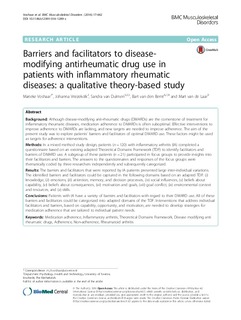| dc.description.abstract | Background: Although disease-modifying anti-rheumatic drugs (DMARDs) are the cornerstone of treatment for inflammatory rheumatic diseases, medication adherence to DMARDs is often suboptimal. Effective interventions to improve adherence to DMARDs are lacking, and new targets are needed to improve adherence. The aim of the present study was to explore patients’ barriers and facilitators of optimal DMARD use. These factors might be used as targets for adherence interventions. Methods: In a mixed method study design, patients (n = 120) with inflammatory arthritis (IA) completed a questionnaire based on an existing adapted Theoretical Domains Framework (TDF) to identify facilitators and barriers of DMARD use. A subgroup of these patients (n = 21) participated in focus groups to provide insights into their facilitators and barriers. The answers to the questionnaires and responses of the focus groups were thematically coded by three researchers independently and subsequently categorized. Results: The barriers and facilitators that were reported by IA patients presented large inter-individual variations. The identified barriers and facilitators could be captured in the following domains based on an adapted TDF: (i) knowledge, (ii) emotions, (iii) attention, memory, and decision processes, (iv) social influences, (v) beliefs about capability, (vi) beliefs about consequences, (vii) motivation and goals, (viii) goal conflict, (ix) environmental context and resources, and (x) skills. Conclusions: Patients with IA have a variety of barriers and facilitators with regard to their DMARD use. All of these barriers and facilitators could be categorized into adapted domains of the TDF. Interventions that address individual facilitators and barriers, based on capability, opportunity, and motivation, are needed to develop strategies for medication adherence that are tailored to individual patient needs. | nb_NO |

